-
收藏模板
- 模板信息
- 更新时间:2023-09-09
- 字数:约56295字
- 页数:约39页
- 格式:.doc
- 推荐版本:Office2016及以上版本
- 售价:5 金币
您可能喜欢的文档
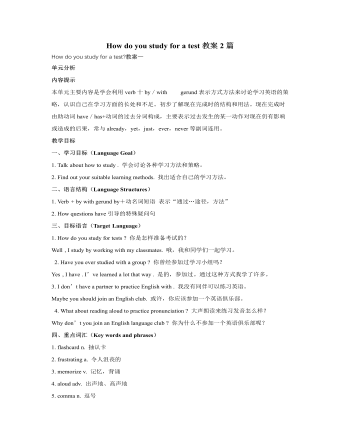
人教版新目标初中英语九年级上册How do you study for a test教案2篇
内容提示本单元主要内容是学会利用verb十by/with gerund表示方式方法来讨论学习英语的策略,认识自己在学习方面的长处和不足。初步了解现在完成时的结构和用法。现在完成时由助动词have/has+动词的过去分词构成,主要表示过去发生的某一动作对现在仍有影响或造成的后果,常与already,yet,just,ever,never等副词连用。教学目标一、学习目标(Language Goal) 1. Talk about how to study . 学会讨论各种学习方法和策略。2. Find out your suitable learning methods. 找出适合自己的学习方法。 二、语言结构(Language Structures) 1. Verb + by with gerund by+动名词短语 表示“通过…途径,方法” 2. How questions have引导的特殊疑问句 三、目标语言(Target Language) 1. How do you study for tests ? 你是怎样准备考试的?Well , I study by working with my classmates. 哦,我和同学们一起学习。2. Have you ever studied with a group ? 你曾经参加过学习小组吗?Yes , I have . I’ve learned a lot that way . 是的,参加过。通过这种方式我学了许多。
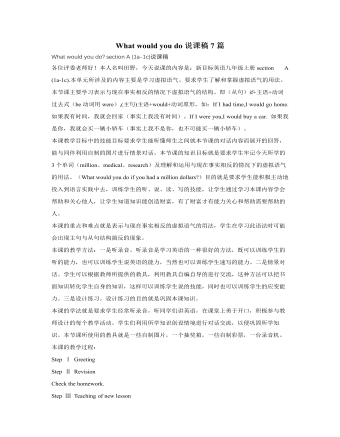
人教版新目标初中英语九年级上册What would you do说课稿7篇
Get students to complete the activity in groups of four. As the groups work together, move around the room to make sure students discuss the topic in English and know how to fill in the chart.Check the answers by asking different pairs of students to say their conversations to the class.Answers will vary.Optional activityAsk, What would you do if there were no classes tomorrow? Ask students to write as many answers as they can. Then get students to work in pairs. One ask the other the question and see how many new answers the other is able to think of.Step Ⅴ SummarySay, In this class, we've done a lot of reading, speaking and writing practice using the target language.Step Ⅵ Homework(1) Review the target language by reading the conversations in Activity 3a.(2) Finish off the exercises on pages 11~12 of the workbook.Step Ⅶ Blackboard DesignWhat would you do?Section AThe Third PeriodTarget language:A: I can't sleep the night before an exam. Then I'm too tired to do well. What should I do?B: If I were you, I'd take a long walk before going to bed. That should help you relax.A: I really want a dog, but my parents won't let me have one.B: Well, dogs can be a lot of trouble. Maybe you should get a small pet, like a goldfish.A: That's a good idea.
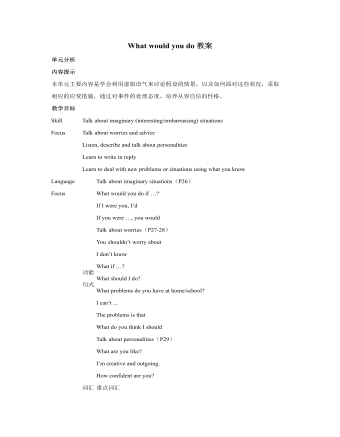
人教版新目标初中英语九年级上册What would you do教案
本课采用任务型教学法,用What would you do if you had a million dollars?这个问句,引出谈论假想情况的话题。 采用提问、启发和归纳的教法,让学生易于接受教材内容,培养学生的语言运用能力。 四、 教学过程设计 Step Ⅰ. Greet the whole class as usual. Step Ⅱ. Warming-up T: Do you have ten Yuan in your pocket? S1: No, I don’t. T: (Take out ten Yuan and give it to the student) OK, never mind. What would you do if it was yours? What would you do if you had ten Yuan? S1: I would buy snacks. T: OK, thank you. Sit down, please. (To the whole class) Just now, it was only ten Yuan. What about 100 Yuan? What would you doif you had 100 Yuan? S2: I’d buy a beautiful jacket. T: Thank you. (To the whole class) Now suppose you had a million dollars, what would you do? We know thatone dollar nearly equals eight Yuan, so that’s a large sum of money. Think it over carefully and tellme your ideas. What would you do if you had a million dollars? S3: I’d buy a big house. S4: I’d buy a sports car. S5: I’d put it in the bank. T: OK, stop here. Please look at the blackboard and guess what would I do if I had a million
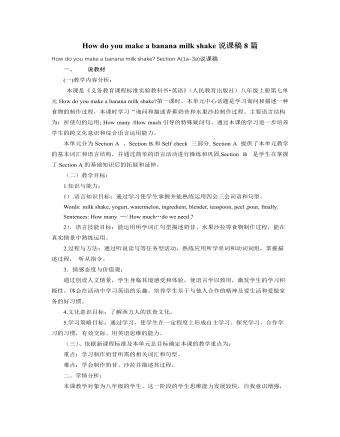
人教版新目标初中英语八年级上册How do you make a banana milk shake说课稿8篇
(五)教学过程1)在课的开始检查学生对单词短语的掌握2)1b,听力为了让学生了解香蕉奶的制作过程,让学生复述,是为了然他们用所学的重点 词汇进行练习、为后面制作水果沙拉奠定基础。3)2a2b的听力是为了复习how much 与how many的区别 ,因为七年级上册unit8涉及到的知识,所以2a2b训练的的真正目的是为了让学生更清楚的了解不可数名词的表达方式 :数词+量词 +of+不可数名词4)在学生完全弄懂事物的制作过程极其不可数名词的数量表达后,我安排他们进行制作水果沙拉的对话。这个对话是机动的,如果时间充足,我让他们按照自己的医院去选择材料进行对话的编排。这个话题既可以用到本科的重点句型,又可用到重点词汇。在这步抓住重点突出难点5)在consolidate 环节,我安排2个汉译英,4个有关how much/how many 的选择,让学生讲做题原因,让他们彻底弄懂不可数名词的数量表达。6)最后,为了加深学生对食物制作过程描述的巩固,让学生把所学知识从口落实到笔头
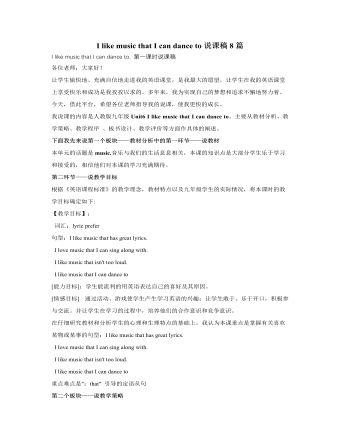
人教版新目标初中英语九年级上册I like music that I can dance to说课稿8篇
2、 难点结合功能句进行听力练习。确定目标的根据新课程标准规定,通过听、说、读、写的训练,使学生获得英语基础知识和初步运用英语进行交际的能力,激发学生的学习兴趣,为进一步的学习打基础。此外,根据我国国情及新课程标准的要求,现阶段英语教学的素质主要包括思想素质教育,潜在英语能力的培养,非智力因素的培养等几个方面。而我们班的学生本身英语基础不太好,部分学生已经对英语失去了信心,还有一部分学生觉得英语越来越难,渐渐力不从心了,不感兴趣了,上课注意力也不集中了。针对这种情况,备课时要增加趣味性,以此来提高学生对英语的学习兴趣。二、教法学法1、 教法:采取“任务型”教学法。教师根据本节课内容,安排合适的任务,让学生在完成任务的过程中达到本节课所拟定的目标。
- 查看更多相关Word文档
How do you study for a test说课稿8篇
How do you studyfor a test? Section A说课稿一
Ladies and Gentlemen:
上午好。今天我说课的内容是GO FOR IT新目标英语九年级Unit1. Section A.Period 1的内容。
一、教材内容分析:

本单元以How to study for atest?为主线,让学生感受动名词的使用环境;充分掌握动名词的用法。同时改进自己学习英语的方法,为今后的英语学习奠定坚实的基础。
二、教学重点和难点:
1.教学重点:
A.句型:What about readingaloud to practice pronunciation?
词汇:aloud, secret,friendship, memorize, frustrate, agreement, disagreement, pronounce.
B. Talking about themethods on learning English.
2.教学难点:
本课时的难点着眼于两个层面,一个为动名词在句中所充当的各种成分,另一个为用口头和书面两种方式表述学习英语的方法。
三、教学目标:
1. 语言知识目标:领略与掌握动名词用法。
2. 文化意识目标:通过本课时的学习,培养人际交往与自省能力。
3. 语言技能目标:能准确运用含有动名词的句型。
4. 学习策略目标:学生能善于利用合作学习,对集体行为表述个体想法,在合作学习中提升个人英语表达能力。
5. 情感态度目标:本课时创设的情境为Talking about theways of how to learn English,学生要体现“公益”精神,集大家智慧,开好一个party,使学生的协作能力在本课时中得到一定程度的提高。
四、任务型活动:
Task1. Whichgroup’s organization of the talk is the best?
Task2. Design a dialog.
Task3. Write apassage about learning English..
五、教学过程设计
1. Greetings.
Talk about theactivities students had last weekend.
复习检查本课的单词(短语),作为本课学习的铺垫与热身。
2. Discussing.
T: How do youstudy for a test?
T: I study bymaking flashcards.
T: What aboutreading aloud?
幻灯展示一些flashcards,引导学生用上述句型讨论。
注意:此时务必要让学生完整表达含有动名词的句式。
3. Pair work: class party.
S1: I think Istudy by memorizing the new words….
S2: But for me, Istudy by listening to the teather carefully
该环节的目的是想让学生强化训练句型和相关的拓展句型。
4. Listening: 1a and 1b
该听力测试难度并不大,学生在听之前的答案预测往往正确率会较高。
5. Group work:
Students work in agroup of 4 to make up a conversation about how to study for a test. Whichgroup’s organization is the best?
提供给学生3个问题,便于学生讨论:
Question 1. Whichis the best way to study English?
Question 2. Howmany ways do you study English by?
Question 3. Whatactivities of learning English are popular in your everyday English studying?
学生小组讨论时,教师要到各小组旁听,引导学生尽量使用重点句型,争取难点有效突破。
6. Listening: 2a and 2b
7. Design: jion a club to learn English.
学生依然以group work形式为即将参加考试的同学设计一个提高英语成绩的学习方法.
8. Writing:
Task1: How do youstudy English every day?
Task2: Whichmethod do you think is the best for you to learn English well?
Task3: If you havea test next week, what will you do to improve your English grade?
9. Homework:
Think about more ways of learning English well and write them down.
六、板书设计:
Unit 1
1, New words
2,句型; How do you study for a test?
I study by makingflashcards.
七、教学评价与预测:
本课时的教学评价应该着眼于以下三个方面:
1. 学生在Group work 中是否能积极参与
2. 学生对于动名词结构,能够主动运用
3. 学生在If对话和写作中,能够了解并正确使用学英语的更多好方法。
本课时的教学预测是学生可能会以比较高的热情参与若干个情景小组讨论中,而难点在于含有动名词的句式表述上,需要课下及时的消化与巩固。 谢谢!
How do you studyfor a test? Section A说课稿二
Goals
●Totalk about how to study
●Toread about how to study
Procedures
Warming up bygreeting
Hello,everyone!
Fromnow on you are a ninth grader. Congratulations to you and I wish you a greatsuccess in your studies!
Todaywe shall take up the first unit in this new term, How do you study for a test?
Lookat the blackboard and read after me the target language for this unit. When youread pay attention to the structure of the sentence.
Learningto Learn is very important. And learning to pass a test is also very importantto you.
Learningcouldn’t be easier!
If youhave not developed good ways or methods to study for a test, talk to yourclassmates about it, your parents, or the teacher like me if you are braveenough. You should be brave enough to talk to others about your problems withyour studies.
NextI’d like to give you some useful practical advice about studying for a test andalso ask you questions to make you think about things such as:
▲usingyour time effectively
▲motivation
▲howto learn your lessons in the ninth grade year
▲differentmodes of teaching you may meet
▲howto develop particular skills, such as note-taking in class
1A: Checkingthe ways you study
Nextturn to page 2 and check √ the ways you study for an English test. Then addother ways you use sometimes.
■Howdo you study for a test?
Nowraise your hand and report your added ways to the class. I will make a list ofall the added ways on the blackboard.
1bListening and writing
Listento understand how these people in the picture on page 2 study for a test. Writeletters from the pictures. While listening, pay attention to the structures ofthe sentences.
1c Doing a pairwork
Now inpairs ask your partner how he or she studies for a test.
2a Listening and checking
Nowlet’s go to page 3. Listen to the tape and check the questions you ask.
Whilelistening, pay attention to the structures of the sentences.
2bListening and matching
Listenagain and match each question from 2a with an answer in the box on page 3.
2c Doinga pairwork
Nextwe are going to make a conversation in pairs using the information fromactivities 2a and 2b.
3aReading the article and completing the chart
1.Readingto the tape
We aregoing to read the article on page 4. First we shall read to the tape together.That is, we start reading aloud as the recorder goes, and we stop reading aloudas the recorder stops. While reading, let’s pay enough attention to the pauses,the pronunciation and the intonation of the native reader. Make our readingaloud as the same as the reader’s.
2.Readingand dividing the article into parts
Nextwe are going to read aloud the article slowly and clearly. We will try todivide it into thought groups.
3.Readingand underlining
Weshall read the article once again, this time, to underline all the usefulexpression_rs in it. After school, you are going to write them down in yournotebook.
4.Translatingand completing the chart
Becauseyou have read this article many times you are going to translate it intoChinese first and then complete the chart on page 4.
Whowill be the first to have a try?
3bDoing a pairwork
Silence,please! We are going to have a role play in pairs. One of the pair is to be one
of thepeople in 3a. The other is to interview him or her about learning English.
4Doing a pairwork
Turnto page 4 to check √what you do to learn English in the box.
How do you studyfor a test? Section A 英文说课稿
一.Teaching material analysis
In thisunit,students learn to talk about how to study for a test.Such a topic is veryuseful to the students so that they can make a great progress after they masterthe right way to study.It’s helpful to raise learning interest of allstudents.Either more or less advanced students will benefit a lot in all theirlife.
二.Teaching aims
1. knowledge objects
In thisunit,students learn to talk about how to study for a test and give advice tothose who have difficulties in studying.
2. ability objects
Let studentsform a good habit of learning english through giving advice. Train the students communicative competence.
3. Moral objects
Everyone learnsin a different way and the best one is to do.Let them know that no pains,nogains.
三.Teaching key points and difficult points
1. key points
words:flashcards,pronunciation,aloudand so on.
Targetlanguage:How do you study for test?---I study by working with a group.
2. Difficult points:
Train students communicative competence
四.
五.Learning methods
Cooperation andcommunication
As we allknow,the main aims of learning english in middle school is to cultivate students abilities of listening,speaking,reading,writing and theirgrammer.To use these methods is helpful to develop students abilities.
六.Teaching procedures
Step1 Greetings
“How do youstudy for a test ?”is the first lesson in the new term,so greetings at thebeginning of the class is necessary.
First,welcomestudents back to school and ask them if they had a good time during the summerholiday.and then ask different students to describe what they did in summervacation, at last,ask them whether did they learn english and how did theylearn.
Step 2 presentation
write the waysthey study english on the blackboard..Let them check the ways they usuallystudy for a test.While students are doing this,write the list of ways ofstudying on the blackbag.
After they havefinished checking the ways,ask the students to look at the blackboard anddiscuss which are the most popular and least popular ways of studying.
3And next, Iwill let the students add other waysthey use sometimes,and invite. Several students to read their waysto the class.
This activityreviews earlier volabulary and introduces some new words.
Step 3 Practive
Firstly,readthe instructions to the class focus the students atlention on the illustrationand point to the pictures labeled a,b and c and elisit how each student isstudying. Then point to the pictures with names Mei. Antonio and pierre undunderneath and tell them listen.
Secondly, askthem write the leter of each picture in front of the name the person.Whostudies that way. Such as, Mei says, I study by making flashcards, so theanswer to number 1 is a, play the tape for the first time, students onlylisten. Play the tape a second time, students write down their answers. After listening, I willinvite several students to check the answer, then I will give the rightanswers.
Step 4Production
First, read theinstructions to the class. And call the students attention to the conversationin the box. Invite a pair of students to read it to the class. And then tellthe students look at the other ways of studying in activity 1 and ask theirpartner how he/she studies for a test. As students work, I will listen in onvarious pairs checking propress and offer help as needed. And after students have a enhance topractice act out their conversation.
This activitygivers students oral practice using the target language therefore, it can improve theirspeaking skill.
七,Summary
In this class,we’ve learned some new words, such as flashcard, vocabulary. And we’ve alsolearned the target language: how do you study for a test? Istudy byworking with group.
八,Homework
Ask students tointerview students in other class, family members, and friends to try todiscover some new ways of studying that haven’t been introduced in the book orin class.
九, Blackboard Design
How do youstudy for a test
Section A
1, Ways ofstudying
By working withfriends by making flashcards
By reading thetextbook by making vocabulary lists
By listening totapesby asking the teacher for help
2, Targetlanguage
A How do you study for test?
B I study by working with a group.
How do you studyfor a test? 第一课时说课稿一
一.教材分析
本单元围绕“How to study”这一话题展开教学活动,帮助学生学会用“verb + by doing”的表达方式探讨学习英语的策略,认清自己在学习方面的长处和不足。本单元的话题跟学生的学生生活有密切联系,学生很感兴趣,也容易理解。通过对一些学习话题的讨论,让学生明白英语学习的重要性,并能够根据所学知识进行交流和学习,了解哪些学习方法适合自己,从而有效地提高英语成绩。同时,也让学生学会面对困难,学会解决问题,养成良好的学习习惯,善于向同学、朋友、老师学习更好的方法,能给他人提出适当的解决方法,树立学好英语的信心。
二、学情分析
学生经过一定时间的学习已经有了一定的语言基础知识,且本单元的话题“How to study”,源于实际的学习生活,因此学生的学习积极性会很高。通过本单元的学习,学会谈论学习生活中遇到的困惑和烦恼,并进行更深入的经验交流。有利于延伸和拓展知识范围,培养解决实际问题的能力。
三、教学目标
1.知识目标
重点词汇: flashcard,vocabulary, aloud , pronunciation
掌握语言结构:verb+ by doing
掌握给出建议的句型: what about,…?
why don’t you…?
2.技能目标
(1)能够介绍自己的学习方法
(2)能够谈论学习中遇到的困难
(3)能够针对学习中遇到的困难给别人提建议
3. 情感目标
(1)了解各种学习方法,培养用正确,科学的方法做事的能力,
明白“一分耕耘,一分收获”的道理
(2)通过学习上的互相帮助,能够形成相互交流,相互促进的学
习氛围
四、教学重难点分析
正确运用” verb + by doing”的表达方式谈论学习中的困难,并提出相应的建议。
五、教学课时
第一课时
六、教学用具
录音机,磁带
七、教学过程
Step Ⅰ Warm up
Greetings
Welcome back to school !Then ask them ifthey had a good time during the summer holidays.
Step ⅠⅠ Lead-in
Now you have finished your holiday, did you study in your holiday ? Howdid you study?
Step Ⅲ Presentation
1. 1a
This activity reviews earlier vocabulary and introduces some new words.
Read the instructions to the class.
Call students attention to the box. Read the list of ways of studying to the class.
Please check the ways you usually study for an English test. While thestudents are doing this, write the list of ways of studying on the blackboard.After they have finished checking the ways, ask the students to look at theblackboard. Ask, who study by working with friends for an English test? Pleaseraise your hands.
Write the number of hands you see after by working with friends on thelist. Repeat the same approach with the other ways of studying on the list.Then discuss which are the most popular and least popular ways of studying.
Say, And now please add other ways you use sometimes. While the studentsare doing this, move around the room to offer language support as needed.Invite several students to read their ways to the class.
2. 1b
This activity provides students practice in understanding the targetlanguage in spoken conversation.
Read the instructions to the class.
Focus attention on the illustration. Point to the pictures labeled a,b andc and elicit how each student is studying. Then point to the pictures withnames Mei, Antonio and Pierre underneath. Say, You will hear one conversation.You are asked to write the letter of each picture in front of the name of theperson who studies that way.
Point out the sample answer to the class.
Call students attention to the speech bubble in the illustration. Say, Meisays, "I study by making flashcards. "so the answer to number 1 is a.
Play the recording for the first time. Students write down their answers.Check the answers .
Step 3. 1c
This activity gives students oral practice using the target language.
Read the instructions to the class.
Call students attention to the conversation in the box. Invite a pair of students toread it to the class,
Say, Now work with a partner. Start by reading the conversation in the boxwith your partner. Then look at the other ways of studying in Activity 1 andask your partner how he or she studies for a test.
As students work, listen and offerhelp as needed.
Ask pairs to come to the front of the room and act out their conversationsafter practice.
4.2a
This activity provides listening practice using the target language.
Call students attention to the picture.
Ask, What do you think is happening? Who are they? Guide the students tosay. They are members of an English club that meets after school once a week.They are talking about the ways to learn English.
Point to the list of questions in the box.
Get different students to read them to the class.
Say, Listen to a conversation among the members of the English club. Checkthe questions you hear.
Point out the sample answer.
Play the recording for the first time.
Students only listen. Play the recording again. This time students listenand check the questions they hear. Check the answers with the whole class.
5. 2b
This activity provides listening practice using the target language.
Point to the list of answers in the box.
Get different students to read the answers to the class.
Point to the checked questions in Activity 2a.
Say, You are to listen to the same conversation again. This time write theletter of the correct answer after each question you checked in Activity 2a.Point out the sample answer. Play the recording again.
Students write the letters in the blanks. If necessary, play the recordingonce more so that students have an opportunity to check their answersthemselves. Check the answers with the whole class.
6. 2c
This activity provides oral practice using the target language. Invite apair of students to read the sample conversation to the class.
Read the instructions. Say, Make conversations using information fromActivities 2a and 2b with a partner. As students work, move around theclassroom and offer help as needed.
Aask pairs to come to the front of the room and act out their conversationsafter practice.
Step Ⅳ Grammar Focus
Invite a student to read the sentences to the class.
Underline the words by listening, by studying and by reading aloud. Say,When you ask how to do something or to tell how you do something, you often usethe word "by" followed by an-ing word.
Step Ⅴ Summary
Say, In this class, we’ve learned some key vocabulary words, such asflashcard, vocabulary, aloud , pronunciation .
And we’ve also learned the the structure verb+by doing.
We should pay special attention to the structure verb+by doing.
八、作业 Homework
Ask students to interview someone else to find some new ways of studyingthat are effective.then write an article about how to study with by + doingstructure.
九、板书设计
How do you study for a test?
Vocabularies: flashcard,vocabulary, aloud , pronunciation
Language structure:verb+ by doing
Sentence patterns: what about…?
why don’t you…?
十、教学反思
通过对一些学习话题的讨论,让学生明白英语学习的重要性,并能够根据所学知识进行交流和学习,了解哪些学习方法适合自己,从而有效地提高英语成绩
Howdo you study for a test? 第一课时说课稿二
大家好:
很高兴能在网上参加这次的英语说课活动,我说课的内容是新目标英语九年级第一单元How do you study for a test ?的第一课时( 1a —— 1c ),本课时所学知识十分贴近学生的实际生活经验,本课话题How to study……与日常生活密切相关,作为一名中学生学会如何学习是非常重要的,发展学生的自主学习能力和合作精神,是基础教育阶段英语课程的任务之一,因此,本课时对于提升学生的学习兴趣而提高听、说、读、写能力有很大的帮助。我的说课包括以下内容:
第一、教材分析。
1、 本课时主要围绕How do you study for a test ?展开,谈论如何学习英语,如何准备考试,通过听、说、读、写的训练,熟练掌握和运用V+by+Ving的语言功能结构,并对学生进行学习策略指导,使他们能采取最合适自己的英语学习方法。
2、 教学目标:
①知识目标:通过本节课的学习,学生能掌握本课时的重点单词及短语,并能灵活运用V+by+Ving结构。
②能力目标:培养学生用V+by+Ving结构,陈述做事的方法及方式。
③情感目标:培养学生在学习中相互学习、相互帮助、相互促进、取长补短,并掌握适合自己的学习方法,养成良好的学习习惯。
④教学重点:掌握重点词汇和功能句。
⑤教学难点:结合功能句V+by+Ving进行听、说、读、写的训练。
第二、学生分析。
所教学生绝大部分来自农村,英语基础差,不知怎样学好英语,很多学生对英语已失去了信心,还有一部分学生心有余而力不足,没有掌握好学习方法,往往是事倍功半,可以借这堂课让学生就怎样学好英语的方法这个话题畅所欲言,达到取长补短、以点带面的教学效果。
第三、教法设计。
1、 词汇教学:采用多媒体、幻灯片及卡片展示,让学生形象直观的学习新单词。
2、 听力方面:教师创设听力情境,并对听力提出适当的问题,供学生思考,让学生感知问题,带着问题去听。
3、 分小组反复操练功能句。根据实际情况,拓展对话内容,让学生从中学会更多有利于自己的学习方法。
第四、教学过程。
1、 复习旧知:
①复习V+ing的几种类型,为学习by+Ving结构作铺垫,
②复习句型:How do you go to school?
I go to school by bike,引出课题:How do you studyfor a test?
2、导入新知:
用幻灯展示图片,教新单词,引出短语make flashcards. make vocabulary lists. 然后教师提问:How do you study the new words?帮助学生用V+by+Ving结构来回答:We study by making flashcards /We study by vocabulary lists 通过本环节直接引出1a内容How do you study for an English test? 提醒学生特别注意本课时功能句V+by+Ving结构,要求学生掌握一些重要短语:work with sb / listen to tapes/ ask sb for help 然后根据1a中的词组,以师生问答的形式进行连锁操练。
教师再设问:Can you think out other ways to study?给予学生更多思维的空间,根据他们的学习经验,补充更多的学习方法。
3、1b听力练习,让学生观察1a中的图片,教师创设听力情境,并对听力提出适当的问题,供学生思考理解,播放录音,核对答案。此任务练习了学生的听力及理解能力。
4、1c 巩固操练:此环节本着积极参与、善于合作的原则,把全班分为若干小组,采取全班互动的方式,鼓励学生善于抓住用英语交际的机会,充分感知,积极体验,大胆实践,以问答的形式,根据幻灯片的提示,反复操练功能句How do you study for a test? I study by……使学生做到熟能生巧。此环节老师要特别关注差生,及时个别辅导,然后鼓励学生想出更多学习英语的好方法,并及时给予充分肯定,让学生在学习过程中体验成功的快乐,从而保护和激励学生的自尊心和自信心,让他们对英语学习有一个积极向上的良好心态。
5、总结:小结本课时的功能句,梳理知识结构。
6、课堂练习:用小黑板展示,做到直观,有助于集体讨论。
7、板书设计:力求做到突出重点,一目了然。
How do you study for a test?
I study by + Ving
第五、教学评价。
本节课遵循了任务型教学理念,以学生为主体,以任务为中心,以培养学生正确的学习方法为目的,充分调动学生的积极性,提高学习的主动性和自主性,使学生积极参与教学,能较流利的表达自己的思想,对较差学生通过知识点反馈,及时个别辅导,使其能够参与到课堂活动中,让全班学生认识到养成勤学善问的良好学习习惯,是非常重要的。
以上是我说课的全部内容,对于您的点评,在此说声“谢谢”。
How do you study for a test? Section B3a—4说课稿
同学们,我们开始了本课的学习,希望我这个小小的学案能成为你学习路上的小帮手,使你成为学习的小能手。
知识目标:
1.通过本节课的学习,要掌握重点词汇有:
realize, matter, afraid, secret, term, trouble, fast
2.我们要学会在写作中运用下列句型,如:
—First of all, it wasn’t easy for me to understand the teacher whenshe talked.
—I was also afraid to speak in class, because I thought myclassmates might laugh at me.
—I decided to take lots of grammar notes in every class.
—She had trouble making complete sentences.
技能目标:能够运用目标语言就英语学习的困难和突破方法进行写作训练。
情感目标:培养同学之间团结互助,共同进步的协作精神。
【课前露一手】
I.你能在3a中找到下面的短语吗?试着写下来。
首先________开始________随后________太快了________没关系________害怕做某事____________ 造完整的句子____________开始做某事___________做笔记______________这个学期_____________
其中的秘密之一________________
II.你在英语学习中存在哪些挑战呢?
I couldn’t ____________________________________________
I often______________________________________________
It isn’teasy___________________________________________
I don’thave__________________________________________
III.你认为解决挑战应该采取哪些有效的措施?
It’s a good way to____________________________________
It doesn’t matter if___________________________________
______________________________________helped me a lot.
I started to_________________________________________
【课堂显身手】
1.师生互动:
(1)Could youunderstand me when I talk in English?
(2)Are you afraid tospeak in class?
(3 ) What isn’t easy about learningEnglish?
(4) What do you do about this?
2.看课前活动II和III.交流一下在英语学习中存在的挑战及采取的措施。
任务一:例文学习 Model composition
How Vivien learned to learn English?
Fast reading:
1.What’s one of the secrets of becoming a good language learner?
Careful reading:Vivien’s Challenges
1. The teacher spoke too quickly, she couldn’t understand
2. She was afraid to speak in class.
3. She couldn’t make complete sentences.
4. English grammar was difficult.
找出作者战胜挑战采取的措施
Her solutions
1._________________________________________________
2. _________________________________________________
3. _________________________________________________
4. _________________________________________________
Deal with the statements about the article.
Listening and reading practice.
任务二:例文分析 Analysis composition
ChallengesSolutions
1. It is adj. for sb. to do →It doesn’tmatter.
2. be afraid to do→start to do
3. couldn’t do → decide to do
4. have trouble doing→enjoy doing
另外,必要的连词会使文章更加连贯和完整。找一找文中出现了那些连词。
First of all,___________________________________________
观察与思考:
1.It wasn’t easy for me to understand the teacher when she talked. 在结构It is adj. for sb. to do中, It是形式主语,动词不定式短语作句子的真正主语。
2.She had trouble making complete sentences.
have trouble doing sth. 的意思是“做某事有困难”,类似的结构还有have problem/difficulty (in)doing sth,其中介词in可以省略。
练一练:1. 学习英语对我们是很重要的
______________________________________
2. 他在学习英语语法方面有困难。
______________________________________
任务三:口头作文 Oral composition
你能用我们刚才所学的语言结构,用一句话描述你在英语学习的四种技能中存在的挑战及采取的措施吗?
1. It is adj. for sb. to do (later on)→It doesn’tmatter.
2. be afraid to do( then )→start to do
3. couldn’t do ( so ) →decide to do
4. have trouble doing ( now ) → enjoy doing
任务四:书面作文 Written composition
网友Lucy在Vivien的博客上发布了她在英语学习中遇到的困难和挑战,请你以Vivien的名义帮她出出主意吧。
Dear Lucy,
I know it isn’t easy to learn__________________, but I have some ideasthat may help. You said you couldn’t understand people who talked fast. Well,you can try to listen for the most important words, not everyword.________________________________________
______________________________________________________________________________________________________________________________________________________________Yours
Vivien
【课后是高手】
I. 根据汉语提示完成句子。
1.一开始老师讲话太快了,我听不懂。
To____________, teacher spoke too__________, and
I couldn’t____________ every word.
2.我害怕课上发言,怕同学笑话。
I_______________ speak in class, because I thought
my classmates might ____________me.
3.我总是不会造完整的句子。
I couldn’t always _____________________________.
4.我在学习语法方面有困难。
I had __________in___________ grammar.
Homework
针对不同程度的同学,你有两种作业可以选择.
A:把你最有效的英语学习方法写下来,介绍给大家。
B:熟读和背诵3a,完成同步学习中本课的内容。
本节课你的表现怎么样,给自己一个评价吧!
Great ( )Good ()Not bad ()
How do you studyfor a test? Section B说课稿
Goals
● To listen aboutlearning English
● To talk aboutlearning English
● To read aboutlearning English
Procedures
Warming up byreading to the recording
Hello, everyone.To begin with, lets listen and read to the recording of the text HOW DO YOULEARN BEST? That is, read aloud to the tape, as fast as the tape goes, asclearly as the native reader reads. OK? Here we go!
My cat speaksEnglish.
Sometimes my catcomes to me and tells me that she is hungry. Or that her leg hurts. How does mycat tell me these things? I dont speak pussy-cat language. 1a Reading andchecking
Learning Englishcan be both easy and difficult. What things are easy for you? And what thingsare difficult for you? Now turn to page 5, read the list on the top and check √the statementsthat are true for you.
1b Making a list
You have read andchecked the statements true for you. Now think and make a list of other thingsdifficult for you, too.
I dont know howto...! 1. I dont know how to use commas. 2. I dont know how to work withothers. 3. I dont know how to make flashcards. 4. I dont know how to read thetextbook. 5. I dont know how to make vocabulary lists. 6. I dont know how tolisten to tape. 7. I dont know how to ask the teacher for help. 8. I dontknow how to study for a test. 9. I dont know how to work with a group. 10. Idont know how to watch English videos. 11. I dont know how to practiceconversations with friends. 12. I dont know how to read aloud to practicepronunciation. 13. I dont know how to learn by using English. 14. I dont knowhow to get more specific suggestions. 15. I dont know how to read Englishmagazines. 16. I dont know how to learn new words. 17. I dont know how tomemorize the words. 18. I dont know how to studying grammar 19. I dont knowhow to watching English movies 20. I dont know how to joining the English club21. I dont know how to improve her English 22. I dont know how to get lots ofpractice 13. I dont know how to ask teachers about the best ways to learn moreEnglish. 2a Listening and checking
Paul is a niceboy. He works hard at his English, but still has many learning challenges. Nowlisten to find out what challenges he has and check them in the box on page 5.
Challenges to Paulat learning English 1._____ cant get the pronunciation right.
2._____ forget alot of new words.
3._____ cantunderstand when people talk to me.
4._____ cantunderstand the words in magazines.
5._____ dont getmuch writing practices. 2b Listening and matching
Now listen again toPaul talking about his challenges at learning English and match them with thesolutions listed in the box on page 5. While listening, pay attention to thestructures of the sentences.
Tapescript
Teacher: You lookworried, Paul.
Boy: I am, MsMitchell. Im having trouble learning English.
Teacher: You saidyou liked English. Whats the problem?
Boy: I cant getthe pronunciation right.
Teacher: Well,listening can help. Why dont you borrow the teachers tapes? You can listen tothem at home and repeat the sentences that are difficult for you.
Boy: Thats a goodidea. But what about all the new words? I forget a lot of new words.
Teacher: You canalways write the new words in your notebook and study them at home. You caneven study in the train on the way to school.
Boy: That mightreally help! Thanks.
Teacher: Can youunderstand when people talk to you?
Boy: Well, no. Notalways. Sometimes I just dont understand what people are saying.
Teacher: Why dontyou join an English language club to practice speaking English? The Englishclub meets after school on Tuesdays and Thursdays.
Boy: Maybe Illgo. The only other problem I have is that I dont get much writing practice.
Teacher: Maybe youshould find a pen pal.
Boy: That soundslike a fun way to practice writing. Thanks, Ms Mitchell. 2c Doing pairwork
IN pairs we aregoing to role play conversations using the information from activities 2a and2b.
I dont have apartner to practice English with. Maybe you should join an English language club.I cant get the pronunciation right. Listening can help. I forget a lot of newwords. Write the new words on cards and study them daily. I cant understandwhen people talk to me. You can join an English club to talk to people more inEnglish. I cant understand the words in magazines. You can look them up in adictionary. I dont get much writing practices. Start writing an English diaryevery day. I read very slowly. You should read to the recording of the text. Imake mistakes in grammar. Why dont study the basic sentence patterns 3aReading and cutting
Its time to readthe text HOW I LEARN ENGLISH. Now read and check (/) the sentences.
We are going toread the text again to study the form and function of all the predicate verbs.
How I learned tolearn English Last year/ my English class/ was difficult/ for me. First of all,it wasnt easy/ for me/ to understand the teacher/ when she talked to theclass. To begin with, she spoke/ too quickly, and I couldnt understand everyword. Later on, I realized that/ it doesnt matter/ if you dont understand/every word. Also/ I was afraid to speak/ in class, because/ I thought/ myclassmates/ might laugh at me. I couldnt always make complete sentences,either. Then/ I started to watch English-language TV. It helped/ a lot. I thinkthat/ doing lots of listening practice/ is of the secrets of becoming a goodlanguage learner. Another thing/ that I found/ very difficult/ was Englishgrammar. So/ I decided to take lots of grammar notes/ in every class. Then/ I startedto write my own original sentences/ using the grammar/(that) I was learning.Its amazing/ how much/ this helped. Now/ I am enjoying learning English/ and Igot an A/ this term. My teacher is very impressed. Next we shall read the textfor the third time to underline all the useful expressions. After class you areto copy them into your notebook.
All right, readthe text the fourth time and circle all the signal words, or the linking wordswhich connect all the short sentences.
Now you may readthe statements in the box on page 6 following the text. Write "T" or"F" beside each statement.
3b Writing aletter
Your friend LinFeng is having difficulties with her English. Write her a letter telling herhow to become a better English learner.
Dear Lin Feng,
I know it isnteasy to learn English, but I have some ideas that may help. You said youcouldnt understand people who talked fast. Well, you can try to listen for themost important words, not every word. It is difficult to understand by listeningwhat you have not read or what you cant understand well by reading. To listenwell you have to read well. So keep on reading English. Listening and readingto the recording of the text is very important, too. Every text, after beingread, should be listened to and read aloud to the tape. At first you may findit difficult to follow the reader reading aloud the text. Dont worry. If youkeep practicing you will be able to read aloud as fast as the native readerfrom the tape. And then you can understand people who talk fast in English.
Yours,
Tai Zuo 3c Writingan article
You have beenlearning English for at least three years. That is such a long time. Now thinkabout the things that have helped you the most in learning English. Write anarticle telling others about them.
4 Doing aninterview
Next we shall doan interview in groups of four. Ask the three group mates about learningEnglish. Take notes of what they say. Tomorrow you shall stand to tell theclass about their answers.
Q. What isnt easyabout learning English? A. Reading is not easy. Q. What do you do about this?A. I try to cut the sentences into thought groups. Q. What is your favorite wayto learn more English? I read and read aloud a lot. These are the best way.Closing down by sing
To end this periodlets sing an English song.
Rain, rain, goaway,
Come again anotherday,
Little Johnny
Wants to play.
Rain, rain, go toSpain,
Never show yourface again.
Howdo you study for a test?说课稿
two periods
Structures: verb+by with gerund |
Target language: -How do you study for test? -Well, I study by working with my classmates. -Have you ever studied with a group? -Yes, I have. I’ve learned a lot that way. -I don’t have a partner to practice English with. -Maybe you should join an English club. |
Vocabulary: flashcard, take notes, frustrating, memorize, aloud, comma, make mistakes, pronunciation, be afraid to, What about…? Why don’t you…? |
Learning strategies: Personalizing, Role playing |
Section A
Goals
●To talk about how to study
●To read about how to study
Procedures
Warming up by greeting
Hello, everyone!
From now on you are a ninth grader. Congratulations to you and I wish you agreat success in your studies!
Today we shall take up the first unit in this new term, How do you studyfor a test?
Look at the blackboard and read after me the target language for this unit.When you read pay attention to the structure of the sentence.
▲How do you study for test? ▼Well, I study by working with my classmates. ▲Have you ever studied with a group? ▼Yes, I have. I’ve learned a lot that way. ▲I don’t have a partner to practice English with. ▼ Maybe you should join an English club. |
Learning to Learn is very important. And learning to pass a test is alsovery important to you.
Learning couldn’t be easier!
If you have not developed good ways or methods to study for a test, talk toyour classmates about it, your parents, or the teacher like me if you are braveenough. You should be brave enough to talk to others about your problems withyour studies.
Next I’d like to give you some useful practical advice about studying for atest and also ask you questions to make you think about things such as:
▲using your time effectively
▲motivation
▲how to learn your lessons in the ninth grade year
▲different modes of teaching you may meet
▲how to develop particular skills, such as note-taking in class
1A: Checking the ways you study
Next turn to page 2 and check (√) the ways you study for an Englishtest. Then add other ways you use sometimes.
■How do you study for a test?
I study for a test___ By reading to the tape;By underlining the expressions; By reading beyond the text; By doing used exam papers; By going over exercises books; By copying down the text; By learning the text by heart; By speaking with classmates |
Now raise yourhand and report your added ways to the class. I will make a list of all theadded ways on the blackboard.
1b Listening and writing
Listen tounderstand how these people in the picture on page 2 study for a test. Writeletters from the pictures. While listening, pay attention to the structures ofthe sentences.
Section A 1b Tape script Boy1: Hey, gang. There’s a big test on Tuesday. I really need some help. Can you tell me how you study for a big test? Voices: Sure! Yes. Sure we will. Boy1: You did really well on the last English test, didn’t you, Mei? Girl1: Yeah, I did OK. Boy1: Well, how did you study? Girl1: By making flashcards. Boy1: Maybe I’ll try that. How did you study, Pierre? Boy2: By asking the teacher for help. She was really happy I asked. Boy1: That’s interesting. How do you study, Antonio? Boy3: I like to study by listening to cassettes. But sometimes my mother thinks I’m listening to music. And then she gets mad. Boy1: Oh, well… |
1c Doing a pairwork
Now in pairs askyour partner how he or she studies for a test.
A: How do you study for a test? |
B: I study by working with a group. |
C: I study by listening to English. |
D. I study by playing games with my classmates. |
E. I study by doing actions such as coloring, matching. |
F. I study by singing English songs. |
G. I study by writing letters and emails. |
H. I study by acting out simple dialogues. |
I. I study by listening to and understanding stories. |
J. I study by writing simple sentences. |
K. I study by imitating from the recording. |
L. I study by speaking out words or phrases. |
M. I study by doing simple role plays. |
N. I study by reading and understanding simple stories. |
O. I study by using daily expressions. |
P. I study by performing short plays. |
Q. I study by performing simple rhymes. |
R. I study by writing sentences for pictures. |
S. I study by writing out simple poems. |
T. I study by reading aloud correctly. |
U. I study by playing text plays. |
V. I study by working with classmates. |
W. I study by going over the text before class. |
X. I study by copying words and expressions. |
Y. I study by looking and saying. |
Z. I study by asking others questions. |
2a Listening and checking
Now let’s go topage 3. Listen to the tape and check the questions you ask.
While listening,pay attention to the structures of the sentences.
Section A 2a, 2b Tape script Girl1: Welcome to the English club. Today we’re going to talk about the best ways to learn English. Who has an idea? Boy1: Do you learn English by watching English-language videos? Girl2: No. It’s too hard to understand the voices. Boy1: What about keeping a diary in English? Do you learn English that way? Girl2: I think so. It helps to write English every day. Girl3: Have you ever studied with a group? Girl2: Yes, I have! I’ve learned a lot that way. Girl1: Do you ever practice conversations with a friend? Girl2: Oh, yes. It improves my speaking skills. Boy1: What about reading aloud to practice pronunciation? Girl3: I do that sometimes. I think it helps. Boy2: I do too. And I always look up new words in a dictionary. Girl3: That’s a great idea! |
2b Listening and matching
Listen again andmatch each question from 2a with an answer in the box on page 3.
2c Doing a pairwork
Next we are goingto make a conversation in pairs using the information from activities 2a and2b.
A: Have you ever studied with a group? B: Yes, I have. I’ve learned a lot that way. |
A: Have you ever learned English by watching videos? B: Yes, I have. I’ve learned a lot that way. |
A: Have you ever practiced conversations with friends? B: Yes, I have. I’ve learned a lot that way. |
A: Have you ever listened to tapes? B: Yes, I have. I’ve learned a lot that way. |
A: Have you ever read aloud to practice pronunciation? B: Yes, I have. I’ve learned a lot that way. |
3a Reading the article and completing the chart
1.Reading to the tape
We are going toread the article on page 4. First we shall read to the tape together. That is,we start reading aloud as the recorder goes, and we stop reading aloud as therecorder stops. While reading, let’s pay enough attention to the pauses, thepronunciation and the intonation of the native reader. Make our reading aloudas the same as the reader’s.
2.Reading and dividing the article into parts
Next we are goingto read aloud the article slowly and clearly. We will try to divide it intothought groups.
3.Reading and underlining
We shall read thearticle once again, this time, to underline all the useful expressions in it.After school, you are going to write them down in your notebook.
This week/ we asked students/ at New Star High School/ about the best ways/ to learn more English. Many said/ they learnt/ by using English. Some students had more specific suggestions. Lillian Li, for example, said/ the best way/ to learn new words/ was by reading English magazines. She said that/ memorizing the words of pop songs/ also helped/ a little. When we asked about studying grammar/ she said, “I never study grammar. Its too boring.” Wei Ming feels differently. Hes been learning English/ for six years/ and really loves it. He thinks/ studying grammar /is a great way/ to learn a language. He also thinks that/ watching English movies/ isnt a bad way/ because he can watch the actors/ say the words. Sometimes, however, he finds watching movies/ frustrating/ because the people speak too quickly. Lin Chang said that/ joining the English club/ at school/ was the best way/ to improve her English. Students get lots of practice/ and they also have fun. She added that/ having conversations/ with friends/ was not helpful/ at all. "We get excited/ about something/ and then/ end up speaking/ in Chinese,” she said. |
4.Translating and completing the chart
Because you haveread this article many times you are going to translate it into Chinese firstand then complete the chart on page 4.
Who will be thefirst to have a try?
Ways of learning English | |||
| Not successful | OK | Successful |
Lillian Li | Studying grammar | memorizing the words of pop songs | reading English magazines |
Wei Ming | watching movies | watching English movies | studying grammar |
Liu Chang | having conversations/ with friends |
| joining the English club |
3b Doing a pairwork
Silence, please!We are going to have a role play in pairs. One of the pair is to be one of thepeople in 3a. The other is to interview him or her about learning English.
Zhao: Excuse me, Li Hong. Could you help me with my English? Li: Yes, please. What’s the matter? Zhao: I have difficulty studying grammar. Li: Grammar? I never studying grammar. I study English mostly by memorizing the words of pop songs. Zhao: No grammar at all? Li: Yes, I did study grammar. But I study it by reading English magazines. I put grammar learning into reading articles. That is the best way to understand English grammar. |
4 Doing a pairwork
Turn to page 4 tocheck √what you do to learn English in the box.
Closing down by asking and answering—How did you learn English?
*I listened to English them every day.
*I read English books many times a day.
*I learned many English songs by heart.
*I sang the English songs to myself.
*I learned every new English word in the text.
*I learn English by going to English classes.
*I do English homework at school.
*I read English textbooks in the evening.
*I speak English very slowly.
*I play computer games in English.
*I read a lot of English sentences in the morning.
转载请注明出处!本文地址:
https://www.lfppt.com/worddetails_83936521.html最新说课稿文档
-
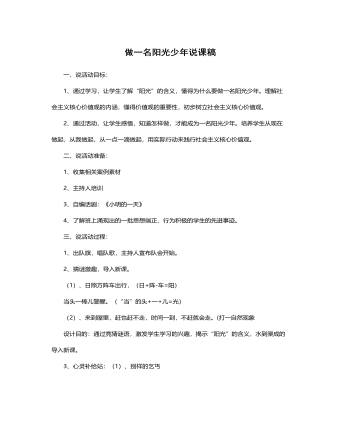
做一名阳光少年说课稿
1、紧密联系学生的生活实际,所选材料、所有活动均本着为主题服务的原则。2、形式多样化。通过心灵补给站、我来当编剧、心动不如行动等丰富多彩的活动,激发学生的热情,充分发挥他们的主体性。3、用生活中的真人真事激励他们,震撼他们的心灵,对学生进行教育,让他们得到感悟。五、说评价方式:要真正发挥主题队会的教育作用,千万不能把主题队会开成“检讨会”、“批评会”。兴趣是最好的老师,在课堂上,学生有了兴趣,才会有学习的动机,所以,在教学过程中,我努力把学生当作一个平等的朋友来对待,对于学生的回答进行评价时,本着“多表扬少批评,多鼓励少指责”的原则,尽量不用指令性、批评性的语言,最大限度的挖掘学生的优点,进行激烈性评价。

追思先烈魂,弘扬爱国情说课稿
环节四深入实践——弘扬爱国情爱国不是一句口号,要将爱国情怀落实到行动中去,队员们在各队队长的组织下,商讨出了落实方案。1、第一小队和第二小队组成了先烈故事演讲团,利用班会十分钟的时间,在三四年级宣讲先烈故事。2、第三小队和第四小队组成了创编小能手,编唱了爱国童谣、爱国拍手歌,告诉大家,爱国无处不在,爱国要从小事做起。3、第五小队和第六小队编写的爱国倡议书,提倡大家让爱国从口号落实到行动。4、全体队员共同宣誓:时刻准备着,为共产主义事业而奋斗,将活动推向了高潮。环节五大队辅导员总结“风雨沧桑,多遭铁蹄践踏,未有沉沦终奋起;荡涤污浊,重聚华夏精魂,披荆斩棘勇向前。”让我们牢记自己是中国人,怀一颗中国心,明确方向,努力奋斗,早日实现自己的梦想。
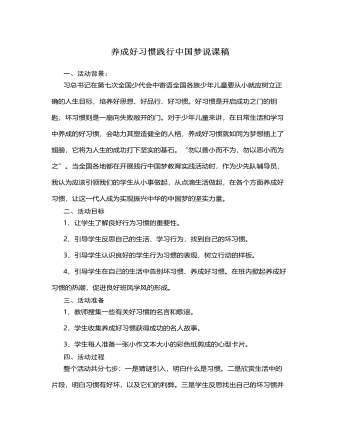
养成好习惯践行中国梦说课稿
第七步:全班学生一起倡读承诺书:(课件出示)我们都是小学生,培养习惯最要紧;上课应当专心听,积极开动小脑筋;作业认真仔细做,按时完成交得勤;有了错误要订正,知识才能学得清;人生要有好习惯,我们牢牢记心上。最后请学生把自己要养成的好习惯写在心意卡上,写好后粘贴在教室后面的园地里,互相督促,使得此次活动教育延续课后,直至影响一生.5、活动效果及反思此次活动开展后,学生们增强了对自身的认识,很多学生下决心改掉自身的坏习惯,并逐步采取了实际行动,从身边的小事做起,而且在学生中间还兴起了互相帮助、互相指正、争相进步的热潮。通过此次活动我也切实的体会到养成教育要开展就要落到实处,从实际出发,让学生亲自去感受,去体会,并且要持之以恒的做下去。同时作为老师更应该有一颗敏感热情的心,随时发现学生身上的闪光点与不足,多指正、多指点、多鼓励、多表扬,做到时时处处皆教育,这样才能赢得孩子,做好教育。
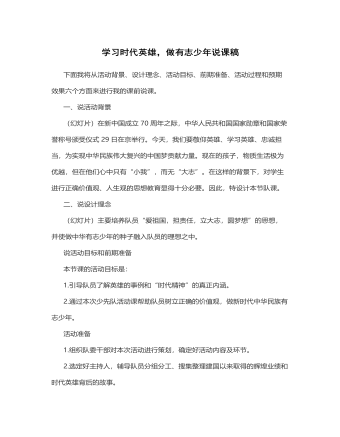
学习时代英雄,做有志少年说课稿
一、说活动背景(幻灯片)在新中国成立70周年之际,中华人民共和国国家勋章和国家荣誉称号颁受仪式29日在京举行。今天,我们要敬仰英雄、学习英雄、忠诚担当,为实现中华民族伟大复兴的中国梦贡献力量。现在的孩子,物质生活极为优越,但在他们心中只有“小我”,而无“大志”。在这样的背景下,对学生进行正确价值观、人生观的思想教育显得十分必要。因此,特设计本节队课。二、说设计理念(幻灯片)主要培养队员“爱祖国,担责任,立大志,圆梦想”的思想,并使做中华有志少年的种子融入队员的理想之中。说活动目标和前期准备本节课的活动目标是:1.引导队员了解英雄的事例和“时代精神”的真正内涵。2.通过本次少先队活动课帮助队员树立正确的价值观,做新时代中华民族有志少年。
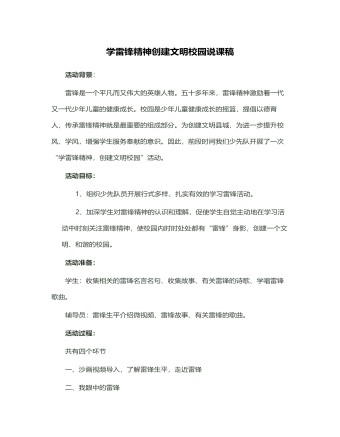
学雷锋精神,创建文明校园说课稿
雷锋精神是什么?这一环节是让学生用简单的词语或句子概括。通过这一活动,让学生概括出雷锋精神的内涵:像无私奉献、乐于助人、为人民服务、勤俭节约、尊老爱幼、勤奋好学、干一行爱一行、言行一致等等都是雷锋精神的体现。我们少年儿童是中国的未来和希望,雷锋精神的发扬和光大,创建文明校园的任务就落在他们的肩上,所以在这里我还设计了为发扬雷锋精神,创建文明校园“我该怎么做”这样的问题,目的就是让他们一起行动起来,学雷锋做好事,并制作了“荣誉”旗,奖励身边的好人好事。活动延伸:这里我设计了一个角色游戏活动——我要义卖献爱心,这个游戏学生们表现得非常积极,他们收集了自己不要的小文具或小玩具,将他们拿到集市上去卖,卖东西获得的钱,捐给王奶奶的孙女,因为王奶奶的孙女生病了,无钱治病。我觉得这个游戏使学生们懂得,一个人只要有爱心,只要愿意去帮助别人,无论什么方式都行,而且在游戏活动中孩子们体会到了帮助别人是一件多么多么快乐的事呀。
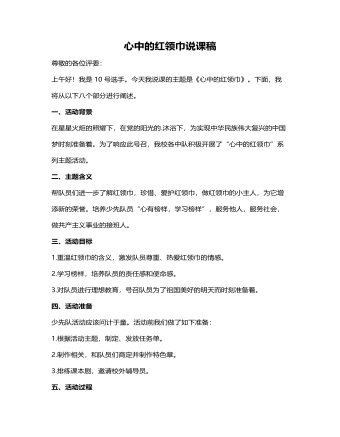
心中的红领巾说课稿
1.学习“最美红领巾”。图文结合,学习“美德少年”刘华婷、刘颖等人的先进事迹。2.记录“平凡红领巾”。展示队员们活动前精心准备的“随手拍”,发现普通队员在日常生活中的闪光点。3.填写“我为红领巾添光彩”心愿卡,对学生进行理想教育。4.齐唱《红领巾之歌》,点燃信念火种。5.辅导员对此次活动进行总结,并颁发特色章。(出示三个特色章图标)六、活动延伸红领巾精神需要代代相传,珍爱红领巾的意识需要时时提醒,本次活动后,我们会开展“小小新四军”、“鲜艳的红领巾”等后续活动,帮助队员们将红领巾精神永远铭记在心。七、引导要点四年级队员具备一定的活动能力和经验,通过课本剧的亲身体验、心愿卡的真情表达等多种方式的运用,引导队员热爱红领巾,以红领巾精神指引自己健康成长。八、活动评价本次活动,队员们受到了良好的教育。但是四年级队员自我约束能力不够强,缺乏持久性,萌生的意识和激情往往只停留在活动时,不能在活动后内化为自觉行为,这些问题有待探究。
今日更新Word
-

精选高中生期末评语
1、该生学习态度端正 ,能够积极配合老师 ,善于调动课堂气氛。 能够积极完成老师布置的任务。学习劲头足,听课又专注 ,做事更认 真 ,你是同学们学习的榜样。但是,成绩只代表昨天,并不能说明你 明天就一定也很优秀。所以,每个人都应该把成绩当作自己腾飞的起 点。2、 你不爱说话 ,但勤奋好学,诚实可爱;你做事踏实、认真、为 人忠厚 ,是一个品行端正、有上进心、有良好的道德修养的好学生。在学习上,积极、主动,能按时完成老师布置的作业,经过努力 ,各 科成绩都有明显进步,你有较强的思维能力和学习领悟力,学习也有 计划性,但在老师看来,你的潜力还没有完全发挥出来,学习上还要有持久的恒心和顽强的毅力。
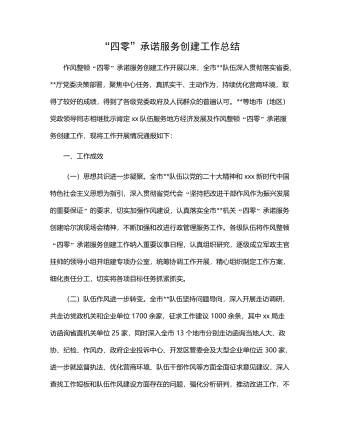
“四零”承诺服务创建工作总结
(二)坚持问题导向,持续改进工作。要继续在提高工作效率和服务质量上下功夫,积极学习借鉴其他部门及xx关于“四零”承诺服务创建工作的先进经验,同时主动查找并着力解决困扰企业和群众办事创业的难点问题。要进一步探索创新,继续优化工作流程,精简审批程序,缩短办事路径,压缩办理时限,深化政务公开,努力为企业当好“保姆”,为群众提供便利,不断适应新时代人民群众对政务服务的新需求。(三)深化内外宣传,树立良好形象。要深入挖掘并及时总结作风整顿“四零”承诺服务创建工作中形成的典型经验做法,进一步强化内部宣传与工作交流,推动全市创建工作质效整体提升。要面向社会和公众庄严承诺并积极践诺,主动接受监督,同时要依托电台、电视台、报纸及微信、微博等各类媒体大力宣传xx队伍作风整顿“四零”承诺服务创建工作成果,不断扩大社会知情面和群众知晓率。
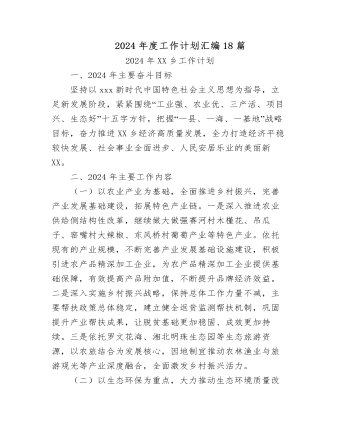
2024年度工作计划汇编(18篇)
1.市政基础设施项目5项,总建设里程2.13km,投资概算2.28亿元。其中,烔炀大道(涉铁)工程施工单位已进场,项目部基本建成,正在办理临时用地、用电及用水等相关工作;中铁佰和佰乐(巢湖)二期10KV外线工程已签订施工合同;黄麓镇健康路、纬四路新建工程均已完成清单初稿编制,亟需黄麓镇完成图审工作和健康路新建工程的前期证件办理;公安学院配套道路项目在黄麓镇完成围墙建设后即可进场施工。2.公益性建设项目6项,总建筑面积15.62万㎡,投资概算10.41亿元。其中,居巢区职业教育中心新建工程、巢湖市世纪新都小学扩建工程已完成施工、监理招标挂网,2月上旬完成全部招标工作;合肥职业技术学院大维修三期已完成招标工作,近期签订施工合同后组织进场施工;半汤疗养院净化和医用气体工程已完成招标工作;半汤疗养院智能化工程因投诉暂时中止;巢湖市中医院(中西医结合医院)新建工程正在按照既定计划推进,预计4月中下旬挂网招标。

驻村工作队2024年第一季度工作总结汇编(4篇)
三是做大做强海产品自主品牌。工作队于xx年指导成立的冬松村海产品合作社,通过与消费帮扶平台合作,在工作队各派出单位、社会团体、个人支持下,已获得逾xx万元销售额。2022年底工作队推动合作社海产品加工点扩建的工作方案已获批,待资金下拨后将正式启动扩建工作。四是积极助企纾困,带动群众增收致富。工作队利用去年建立的xx镇产业发展工作群,收集本地企业在产品销售、技术、人力、资金、运营、用地等方面的需求,并加大xx支持乡村振兴力度,xx助理赴各村委开展多场xx政策支持乡村振兴宣讲活动,本季度有x万元助农贷款获批,xx万贷款正在审批中。在壮大既有产业的同时,完善联农带农机制,一方面鼓励企业雇用本地农户就业,另一方面计划与本地农户签订长期收购合同,让农民种得放心、种得安心,带动当地群众共同致富。

主题教育总结常用提纲大全
第一,主题教育是一次思想作风的深刻洗礼,初心传统进一步得到回归。第二,主题教育是一次沉疴积弊的集中清扫,突出问题进一步得到整治。第三,主题教育是一次强化为民服务的生动实践,赤子之情进一步得到提振。第四,主题教育是一次激发创业担当的有利契机,发展层次进一步得到提升。2.第一,必须提领思想、武装思想。第二,必须聚焦问题、由表及里。第三,必须领导带头、以上率下。第四,必须务实求实、认真较真。3.一是抬高政治站位,坚持大事大抓。二是坚持思想领先,狠抓学习教育。三是突出问题导向,深入整改纠治。四是坚持领导带头,发挥表率作用。4.一是立足“早”字抓筹划。二是着眼“活”字抓学习。三是围绕“统”字抓协调。5.一是形势所需。二是任务所系。三是职责所在。四是制度所定。6.一要提升认识。二要积极作为。三要密切协作。
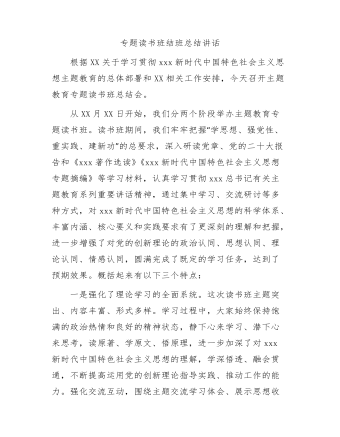
主题教育专题读书班结班总结讲话
第二,要把调查研究贯穿始终,实干担当促进发展。开展好“察实情、出实招”“破难题、促发展”“办实事、解民忧”专项行动,以强化理论学习指导发展实践,以深化调查研究推动解决发展难题。领导班子成员要每人牵头XX个课题开展调查研究,XX月底前召开调研成果交流会,集思广益研究对策措施。各部门、各单位要制定调研计划,通过座谈访谈、问卷调查、统计分析等方式开展调查研究,解决工作实际问题,帮助基层单位和客户解决实际困难。第三,要把检视问题贯穿始终,廉洁奉公树立新风。认真落实公司主题教育整改整治工作方案要求,坚持边学习、边对照、边检视、边整改,对标对表xxx新时代中国特色社会主义思想,深入查摆不足,系统梳理调查研究发现的问题、推动发展遇到的问题、群众反映强烈的问题,结合巡视巡察、审计和内外部监督检查发现的问题,形成问题清单。


















